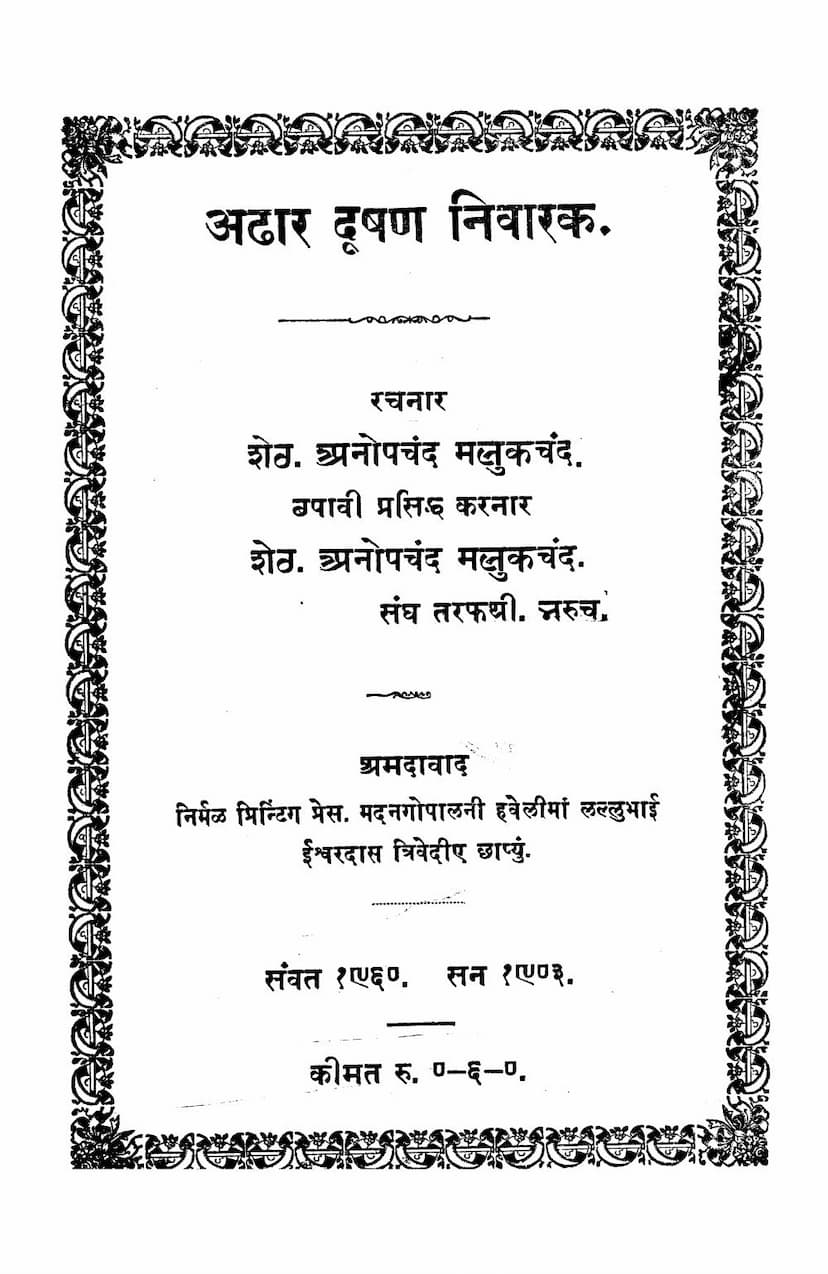Adhar Dushan Nivarak
Added to library: September 1, 2025

Summary
This Jain text, "Adhar Dushan Nivarak" (Remover of Eighteen Flaws), authored by Anopchand Malukchand Sheth, is a comprehensive guide to understanding and overcoming the flaws that bind a soul to the cycle of birth and death. The book aims to establish theistic principles while refuting atheistic views, thereby strengthening the reader's belief in a spiritual path.
The text describes the eighteen flaws that afflict worldly beings and explains how to shed these flaws to attain liberation. It contrasts the flawed state of the soul with the pure, flawless state of the Vitaragas (those who have conquered passions). The author clarifies that this work is based on scriptural evidence and was written to benefit new souls seeking spiritual progress.
Key Themes and Content:
- Theistic Foundation: The book begins by establishing the existence of a soul and an afterlife, refuting atheistic claims that only the physical body exists and that actions have no lasting consequences.
- The Soul (Jiva) and Non-Soul (Ajiva): A significant portion of the book is dedicated to proving the existence of the soul, differentiating it from the non-soul (the physical body and other material elements). The author uses logical reasoning and observation of bodily functions (movement, speech, thought, experience of happiness and suffering) to demonstrate that these are attributed to a conscious entity within the body, which is the soul. The body, being lifeless without the soul, cannot perform these actions.
- Karma and Its Role: The text explains that karma is a subtle substance that binds the soul to the cycle of rebirth. It is through the connection with karma that the soul experiences happiness and suffering, forms relationships, and undergoes the process of life and death. The author emphasizes that karma is not merely the result of effort but a consequence of past actions.
- The Eighteen Flaws (Dushans): The book meticulously details the eighteen flaws that prevent the soul from realizing its true nature and attaining liberation. These flaws include:
- Antarayas (Obstacles): Danantaraya (Obstacle to charity), Gyanantaraya (Obstacle to knowledge), Noganantaraya (Obstacle to the consumption of what is desired), Upbhogantaraya (Obstacle to the enjoyment of desired objects), Viryantaraya (Obstacle to strength/energy).
- Other Flaws: Hashya (Laughter/Mirth), Rati (Attachment/Pleasure), Arati (Displeasure/Discontent), Shok (Grief), Agnan (Ignorance), Mithyatva (False belief/Delusion), Nishcha (Lack of conviction), Avrat (Non-observance of vows), Rag (Attachment/Passion), Dwesh (Aversion/Hatred), and six others implied by the context of the eighteen.
- Charitra (Conduct) and its Pillars: The text elaborates on the five types of conduct that lead to spiritual progress:
- Gyanachara: Conduct related to right knowledge, leading to the manifestation of infinite knowledge.
- Darshanachara: Conduct related to right perception, leading to right faith.
- Charitravachara: Conduct related to right conduct, leading to the soul's adherence to its own nature.
- Tapachara: Conduct related to austerities, purifying the soul.
- Viryachara: Conduct related to the right use of energy, leading to the manifestation of infinite energy.
- The Five Causes: The book highlights that every action or outcome is a result of five causes: Time (Kaal), Nature (Swabhav), Destiny (Niyat), Effort (Udyam), and Past Deeds (Purvakrit). All these must align for an event to occur.
- The Importance of Virtues: The text emphasizes the cultivation of virtues like charity (Dana), good conduct (Sheel), austerities (Tap), and proper behavior (Vinay, Vaiyavach). It details various types of charity and the importance of right intention and recipient.
- Detailed Explanation of Flaws and Virtues: Each of the eighteen flaws and the associated virtues are explained in detail, providing readers with a clear understanding of what to avoid and what to cultivate. For example, the section on Danantaraya explains the five types of charity and the obstacles to giving.
- The Five Senses and Their Role: The text discusses how the senses, when misdirected by passions, become pathways for accumulating karma. By controlling the senses and directing them towards spiritual pursuit, one can overcome these obstacles.
- The Power of Devotion and Right Conduct: The book underscores the significance of showing respect and devotion towards the Vitaragas, their teachings, and the spiritual guides. It outlines various forms of respect and obedience that should be shown.
- The Ideal of the Vitaraga: The text frequently contrasts the suffering and ignorance of the worldly soul with the perfect peace, knowledge, and bliss of the Vitaragas, who have completely conquered all eighteen flaws.
- The Path to Liberation: The ultimate goal described is liberation (Moksha) from the cycle of birth and death, achieved by purifying the soul from all karmic impurities through righteous conduct, knowledge, faith, and austerities.
The book appears to be a didactic text, likely aimed at guiding individuals towards a more disciplined and spiritually aware life within the Jain tradition. It provides a structured approach to understanding the spiritual path by breaking down complex concepts into understandable explanations of flaws, virtues, and practices.